Anticoagulants
Introduction
Various concentrations of subcutaneous heparin sodium, Fragmin, Lovenox, and Arixtra are measured with a tuberculin syringe. Titrated heparin sodium for intravenous drip and titrated Fragmin are calculated for bolus and prophylactic regimens. An example of a flow chart, or medical administration record (MAR), is shown.
 Injectable Anticoagulants
Injectable Anticoagulants
Heparin sodium injection, USP, is a drug used to interrupt the clotting process. It affects the ability of the blood to coagulate, thereby preventing clots from forming. It is used to treat deep vein thrombosis (DVT) and pulmonary embolism (PE); for cardiac surgery; during hemodialysis, myocardial infarction (MI), and disseminated intravascular coagulation (DIC); and prophylactically for immobilized patients. It may be given in therapeutic doses or in small, diluted doses to maintain the patency of IV or intraarterial (IA) lines.
Because it is inactive orally, heparin sodium is administered intravenously or subcutaneously. If administered intramuscularly, the drug produces a high level of pain and may cause hematomas. The orders for heparin are highly individualized and are based on the weight of the patient and coagulation values. Heparin comes in various strengths, including 1000, 5000, 10,000, 20,000, and 50,000 units/mL. Heparin also comes in 10 and 100 units/mL for IV patency flushes. The vial must be checked carefully before administration. Heparin is fast-acting.
Figure 11-1 shows heparin injection sites. Figure 11-2 demonstrates how subcutaneous heparin injections are documented.
Check laboratory values for clotting times before administering heparin. Heparin therapy must not be interrupted and is incompatible with other medications.
Heparin has a half-life of 1 to 6 hours. To maintain a therapeutic level in the blood, heparin is usually given as a continuous IV drip during hospitalization. The heparin level is titrated on the basis of partial thromboplastin time (PTT) levels, which are taken every 6 hours to correlate with the half-life of heparin. Heparin can be counteracted with protamine sulfate.
 CLINICAL ALERT
CLINICAL ALERT
 Heparin is a high-alert medication that carries a risk of causing serious injury if the wrong dosage is administered. It can be confused with insulin as both are measured in units; therefore, have another nurse verify the order and amount before administering heparin, Fragmin, Lovenox, or Arixtra.
Heparin is a high-alert medication that carries a risk of causing serious injury if the wrong dosage is administered. It can be confused with insulin as both are measured in units; therefore, have another nurse verify the order and amount before administering heparin, Fragmin, Lovenox, or Arixtra.
Lovenox (enoxaparin) and Fragmin (dalteparin) (Figure 11-3) are low-molecular-weight anticoagulants. They are prescribed for the prevention and treatment of DVT and PE and also after knee and hip surgery. Lovenox and Fragmin have a longer half-life than heparin, and because of their low level of activity in the blood, there is a reduced need for PTT tests because the two drugs have more predictable peaks and durations of action. The preferred sites for low-molecular-weight anticoagulants are the “love handles,” or anterolateral abdominal wall.
 CLINICAL ALERT
CLINICAL ALERT
Anticoagulant dosages require two licensed nurses to verify dosage for accuracy.
 CLINICAL ALERT
CLINICAL ALERT
Lovenox and Fragmin should never be given in the deltoid because they may cause large hematomas.
Example
Ordered: Lovenox 30 mg subcutaneous q12h after hip replacement. The pharmacy has sent 40 mg/0.4 mL in a prefilled syringe. How many milliliters will be administered? How many milliliters will be discarded?


Arixtra (fondaparinux sodium) is a non-heparin anticoagulant made by chemical synthesis and not from animal origin (Figure 11-4). It is a specific inhibitor of the activated factor X (Xa).

Arixtra is used for prophylasis of venous thromboembolism (VTE), such as deep vein thrombosis (DVT), which may lead to pulmonary embolism (PE) in patients undergoing hip fracture surgery, knee replacement or hip replacement surgery, and those at risk for thromboembolitic complications from abdominal surgery.
Warfarin can be administered in conjunction with Arixtra for the treatment of acute DVT when initiated while the patient is hospitalized.
 CLINICAL ALERT
CLINICAL ALERT
Arixtra is NOT intended for intramuscular use. It CANNOT be used interchangeably with heparin or other low-molecular-weight (LMW) heparinoids such as Lovenox (enoxaparin) and Fragmin (dalteparin).
There is a risk of hemorrhage for patients with impaired renal function and for those who are at increased risk of hemorrhage (thrombocytopenia). If the platelet count falls below 100,000/mm3, discontinue Arixtra.
Subcutaneous Heparin Injections
Example
Ordered: Heparin 3500 units subcutaneous q6h. Available: Vial containing 5000 units/mL. How many milliliters will the patient receive? Shade in the dose on the tuberculin syringe.

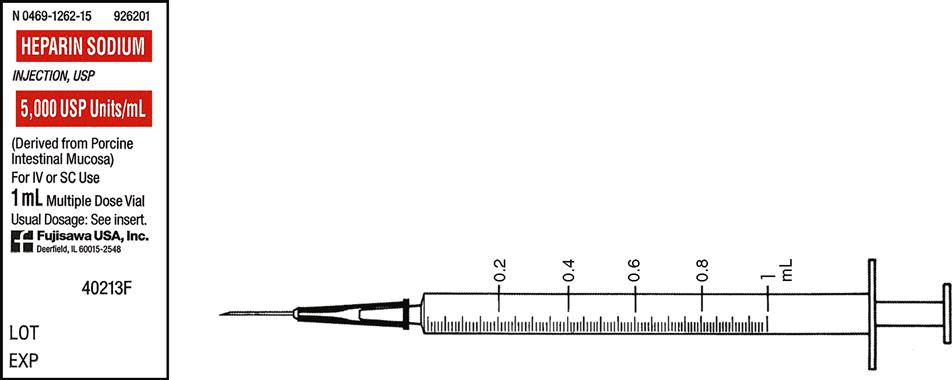
Example
Ordered: Fragmin 8000 international units subcutaneous q6h. How many milliliters will you give? Shade in the dose on the syringe.

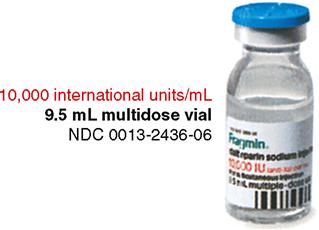
Used with permission from Pfizer, Inc.

 CLINICAL ALERT
CLINICAL ALERT
Do not substitute insulin syringes for tuberculin syringes. Insulin syringes are calibrated in 100 units per mL and tuberculin syringes are calibrated in tenths per mL.
 CLINICAL ALERT
CLINICAL ALERT
Do not massage the injection site because this increases the incidence of bleeding and hematoma development.
Multidose vials are available in 10, 100, 1000, 5000, 10,000, 20,000, and 50,000 units/mL. Read the labels carefully. Answer the following questions and show your proofs (carry out to nearest hundredth). Shade in doses on syringes.
1. Ordered: Heparin 7000 units subcutaneous. Available: Heparin 10,000 units/mL. How many milliliters will the patient receive?

2. Ordered: Heparin 15,000 units subcutaneous q8h. Available: Heparin 20,000 units/mL. How many milliliters will the patient receive?

3. Ordered: Heparin 8000 units subcutaneous q8h. Available: Heparin 20,000 units/mL. How many milliliters will the patient receive?

4. Ordered: Heparin 17,000 units subcutaneous stat dose. Available: Heparin 10,000 units/mL and 20,000 units/mL. Which strength will you choose? How many milliliters will the patient receive?

 CLINICAL ALERT
CLINICAL ALERT
The subcutaneous dosage of heparin should not exceed 1 mL.
5. Ordered: Fragmin 7500 units subcutaneous q6hr. Available: Fragmin 10,000 international units/mL. How many milliliters will the patient receive?

6. Ordered: Heparin 750 units subcutaneous q4h. Available: Heparin 1000 units/mL. How many milliliters will the patient receive?

7. Ordered: Heparin 800 units subcutaneous q8hr. Available: Heparin 1000 units/mL in a multidose vial. How many milliliters will the patient receive?
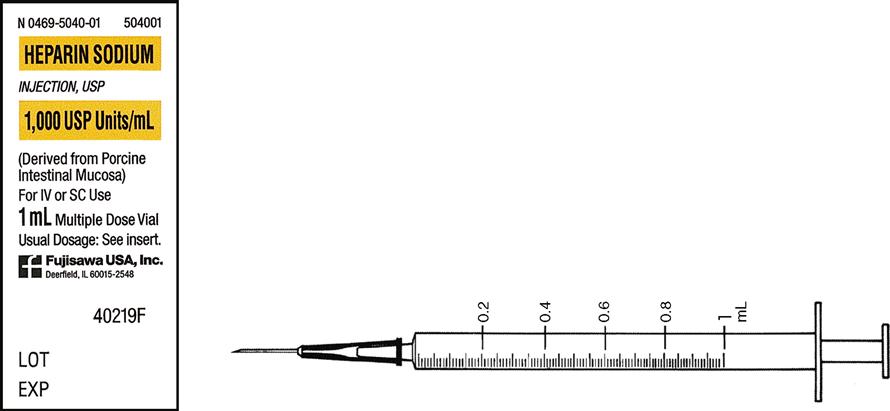
 CLINICAL ALERT
CLINICAL ALERT
Check your patient’s chart for allergies. Heparin is made from pork and beef.
8. Ordered: Heparin 3000 units subcutaneous q8h. Available: Heparin 5000 units/mL in a multidose vial. How many milliliters will the patient receive?
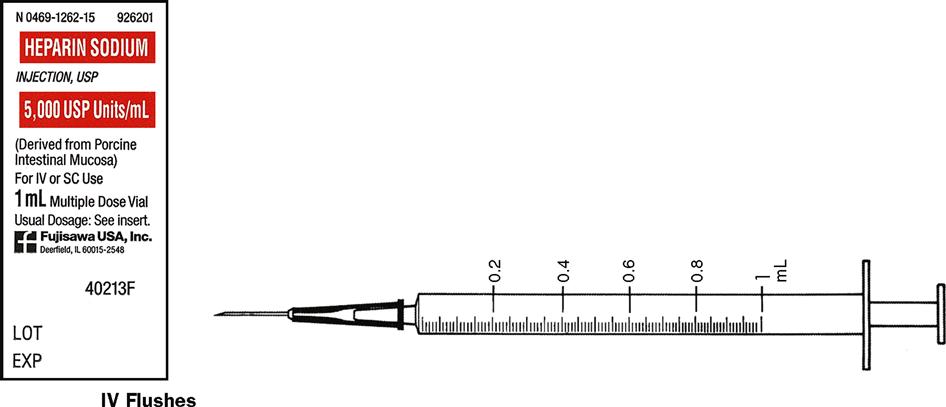
9. Ordered: Heparin flush 5 units after each medication administration to prevent clot formation in the heparin lock. Available: Heparin 10 units/mL. How many units of medication are in the vial? How many milliliters will the patient receive?

 CLINICAL ALERT
CLINICAL ALERT
Heparin resistance has been documented in elderly patients; therefore, large doses may be ordered.
Symptoms of overdose are nosebleed, bleeding gums, tarry stools, petechiae, and easy bruising. An electric razor should be used for shaving.
IV Flushes
IV Flushes
Peripheral lines are flushed with 2 to 3 mL of normal saline using a 5 to 10 mL syringe to reduce pressure on the vein. Heparin locks provide patients with mobility while they are receiving IV medications.
Heparin flushes are used to prevent clot formation in the central line. Central lines are used for access to large veins. Hyperosmolarity solutions can be used without causing vein damage. Heparin flushes come in prefilled 12 mL syringes with 5 mL of 10 units/mL of heparin. Heparin flushes are also available in prefilled 12 mL syringes with 10 mL of 100 units/mL of heparin. Multiple dose vials of various strengths are also available.
 CLINICAL ALERT
CLINICAL ALERT
Heparin IV flushes are available in many different strengths and multiple-dose vials. READ LABELS CAREFULLY. Hospital protocol will determine the amount to administer.
Polypharmacy
 Many people who take prescription drugs also take over-the-counter (OTC) medication. Researchers from the University of Chicago found that about 91% of older adults use at least one medication, and nearly 30% have at least five prescriptions. The study also indicated that many of these older people are taking anticoagulants or antiplatelet agents, which puts them at high risk for adverse drug reactions. It is imperative that all OTC and prescription drugs be charted and the physician notified.
Many people who take prescription drugs also take over-the-counter (OTC) medication. Researchers from the University of Chicago found that about 91% of older adults use at least one medication, and nearly 30% have at least five prescriptions. The study also indicated that many of these older people are taking anticoagulants or antiplatelet agents, which puts them at high risk for adverse drug reactions. It is imperative that all OTC and prescription drugs be charted and the physician notified.
IV Heparin
When intermittent or continuous IV therapy is used, blood should be drawn for a PTT and a hematocrit level to determine the course of therapy. Therapeutic anticoagulant dosage is regulated according to the results of the PTT and the patient’s weight.
Pharmacies are standardizing IV heparin preparations in concentrations of 25,000 units/500 mL and 25,000 units/250 mL. Dispensing charts indicating mL/hr and units/hr are available for each concentration. This will reduce overdosing and underdosing. Protamine sulfate is the antagonist for heparin. It is the nurse’s responsibility to have protamine sulfate available.

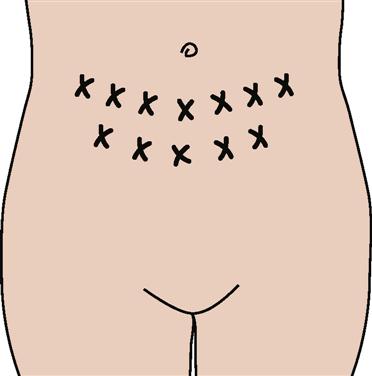
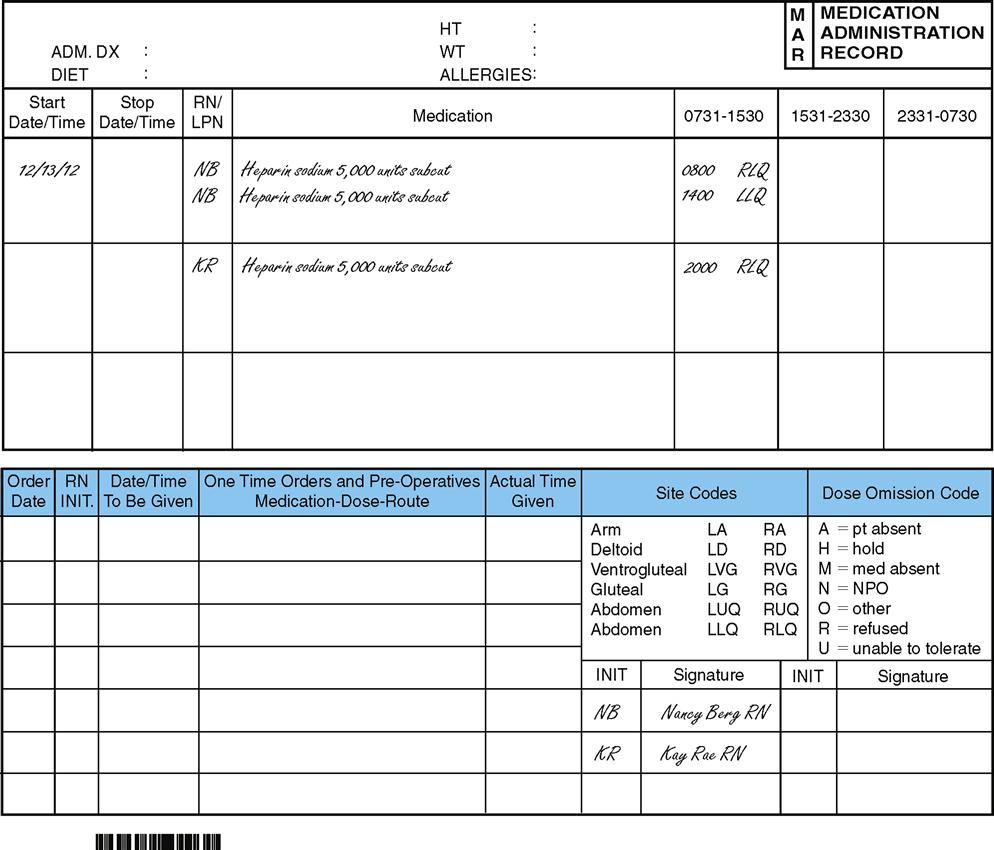
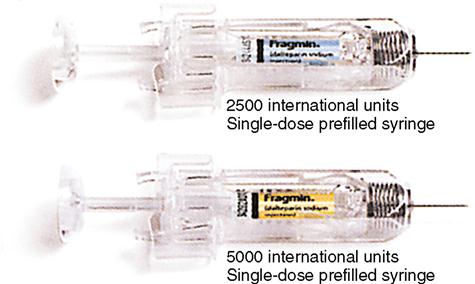
 WORKSHEET 11A
WORKSHEET 11A
 WORKSHEET 11B
WORKSHEET 11B

